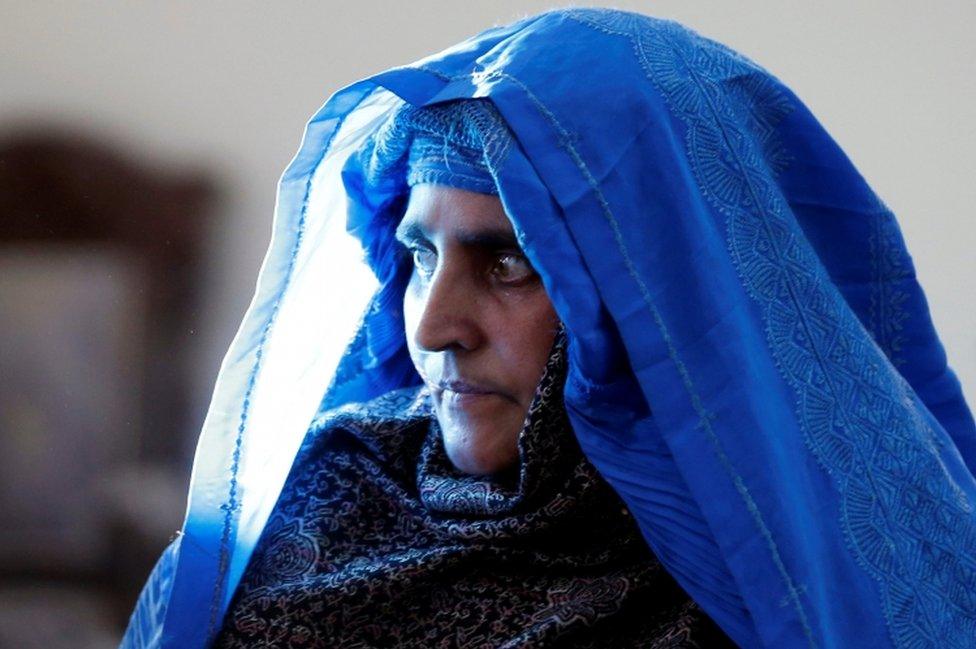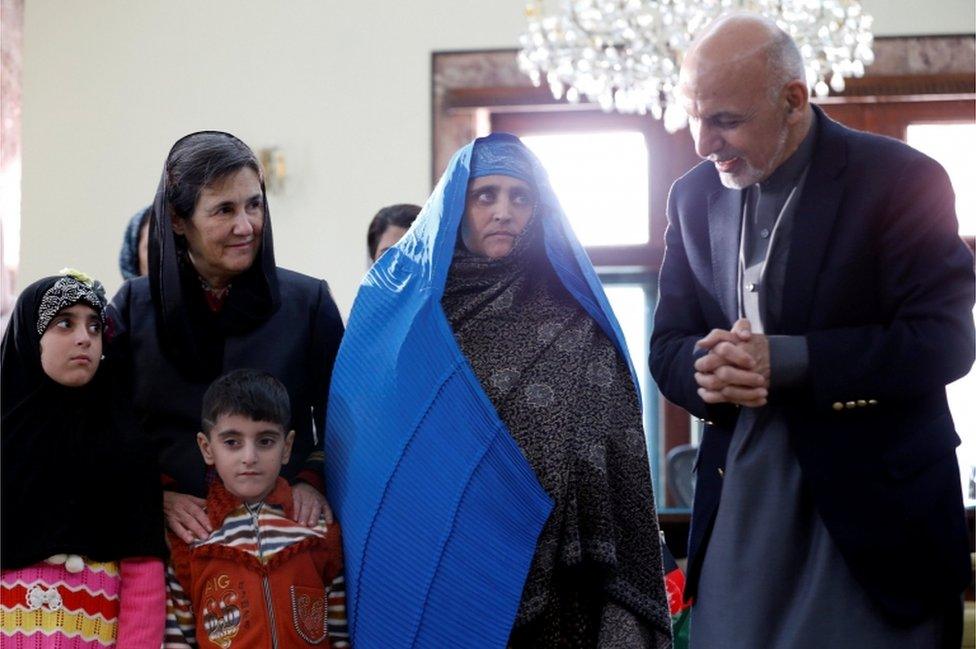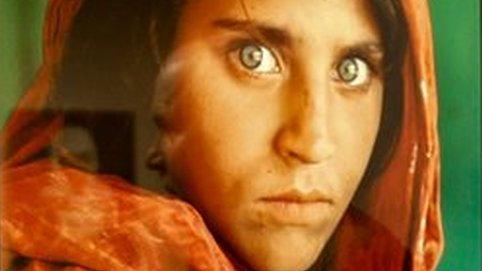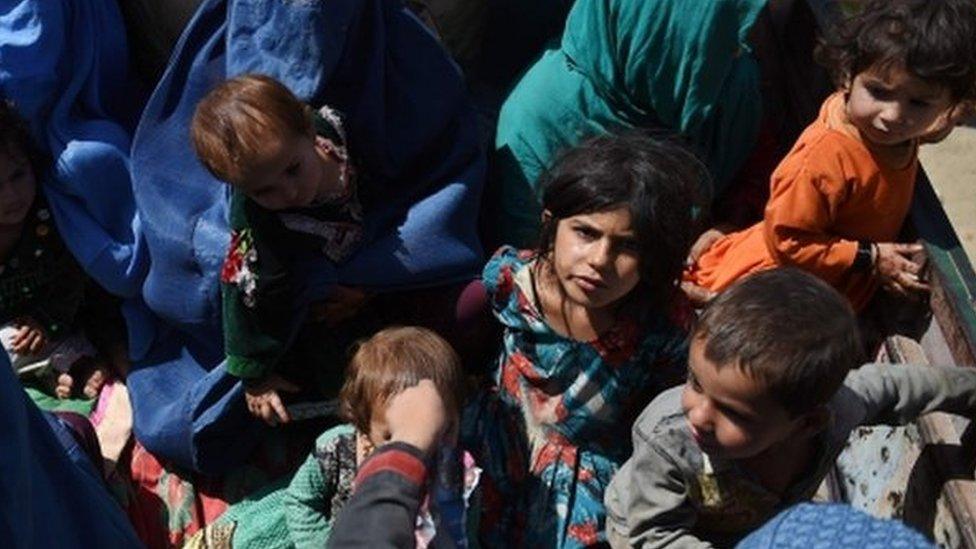‘Afghan girl’ Sharbat Gula in quest for new life
- Published
An Afghan woman made famous by a 1985 National Geographic cover has spoken exclusively to the BBC of her hope for a new beginning, after being deported from Pakistan.
Sharbat Gula now lives with her five-year-old son and three daughters in Kabul, where she says she wants to live a normal life after years of tragedy and hardship.
Her portrait as a 10-year-old became an iconic image of Afghan refugees fleeing war.
The only time she has spoken to the media before now, her family says, was for a 2002 documentary after Steve McCurry, who took her original photo, tracked her down in Pakistan and found out who she was.
Sharbat Gula had no idea that her face had been famous around the world for almost 17 years.
Like many Afghans, she sought refuge in Pakistan and lived there for 35 years - but she was imprisoned and deported last autumn for obtaining Pakistani identity papers "illegally".
"We had a good time there, had good neighbours, lived among our own Pashtun brothers. But I didn't expect that the Pakistani government would treat me like this at the end," Sharbat Gula told me at her temporary residence in Kabul.
Her case highlighted the arbitrary arrest and forced deportation of Afghan refugees in the current spat between the two countries.
It has been illegal for non-Pakistanis to have IDs, external since they were first issued in the 1970s, but the law was often not enforced.
Prison 'the hardest'
Now sick and frail in her mid-40s, Sharbat Gula's haunting eyes are still piercing, full of both fear and hope.
She says she had already sold her house in Pakistan because she feared arrest there for "not having proper documents to stay".
Two days before a planned move back to Afghanistan, her house was raided late in the evening and she was taken to prison.

Sharbat Gula was sentenced to 15 days in prison
Pakistan's government has ordered all two million Afghan refugees on its soil to leave.
Sharbat Gula believes the Pakistani authorities wanted to arrest her before she left.
"I told the police that I have made this ID card for only two things - to educate my children and sell my house - which were not possible to do without the ID card."
She served a 15-day prison sentence, the first week in prison and the second in hospital where she was treated for hepatitis C.
"This was the hardest and worst incident in my life."
Realising the reputational damage, Pakistan later offered to let her stay - but she refused.
"I told them that I am going to my country. I said: 'You allowed me here for 35 years, but at the end treated me like this.' It is enough."
Her husband and eldest daughter died in Peshawar and are buried there.
"If I wanted to go back, it will be just to offer prayer at the graves of my husband and daughter who are buried in front of the house we lived in."
The portrait
The "Afghan Girl" picture was taken by Steve McCurry in 1984 in a refugee camp near Peshawar, when Sharbat Gula was studying in a tent school. Published in 1985, it became one of the most recognisable magazine covers ever printed.
For years she was unaware of her celebrity.
"When my brother showed me the picture, I recognised myself and told him that yes, this is my photo."
How did she feel?
"I became very surprised [because] I didn't like media and taking photos from childhood. At first, I was concerned about the publicity of my photo but when I found out that I have been the cause of support/help for many people/refugees, then I became happy."

Sharbat Gula has now returned to Afghanistan, where the government promised her a house in Kabul
None of Sharbat Gula's six children - another daughter died too at an early age and is buried in Peshawar - share the colour of her eyes.
But her brother, Kashar Khan, does, and the eyes of one of her three sisters were also green.
She says her maternal grandmother had eyes of a similar colour.
Sharbat Gula was a child living with her family in Kot district of eastern Nangarhar province when Soviet forces invaded Afghanistan in 1979.
"There was war between Russians and Afghanistan - that is why we left. A lot of damage/destruction was done."
Her mother died of appendicitis in the village when she was eight. Like hundreds of thousands of other Afghans, her family (her father, four sisters and one brother) migrated to Pakistan and started living in a tent in a refugee camp called Kacha Garahi, on the outskirts of Peshawar.
She was married at 13. But her husband, Rahmat Gul, was later diagnosed with hepatitis C and died about five years ago. Her eldest daughter also died of hepatitis three years ago, aged 22, leaving a two-month-old daughter.
Warm welcome
Sharbat Gula met President Ashraf Ghani in the presidential palace on her return, and later former President Hamid Karzai.
"They gave me respect, warmly welcomed me. I thank them. May God treat them well."

Afghanistan's President Ashraf Ghani received her at the presidential palace
The government has promised to support her financially and buy her a house in Kabul.
"I hope the government will fulfil all its promises," she told me.
Kot district is a stronghold of militants linked to the so-called Islamic State group, so she can't go home to her village. Her green-eyed brother and hundreds of others have fled the area, fearing IS brutality.
"We cannot even visit our village now because of insecurity and don't have a shelter in Jalalabad. Our life is a struggle from one hardship to another," he says.
But Sharbat Gula's priority is to stay in her country, get better and see her children be educated and live happy lives.
"I want to establish a charity or a hospital to treat all poor, orphans and widows," she says.
"I would like peace to come to this country, so that people don't become homeless. May God fix this country."
- Published2 November 2016

- Published26 October 2016

- Published12 October 2016
